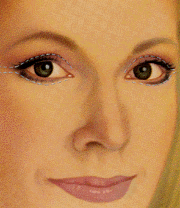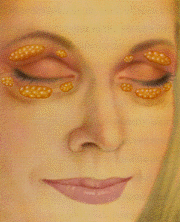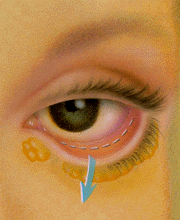Blepharoplasty Toronto Ontario
Eyelid Surgery Toronto Ontario
Eyelid surgery (technically called blepharoplasty) is a procedure to remove fat - usually along with excess skin and muscle from the upper and lower eyelids. Eyelid surgery can correct drooping upper lids and puffy bags below your eyes - features that make you look older and more tired than you feel, and may even interfere with your vision. However, it won't remove crow's feet or other wrinkles, eliminate dark circles under your eyes, or lift sagging eyebrows. While it can add an upper eyelid crease to Asian eyes, it will not erase evidence of your ethnic or racial heritage. Blepharoplasty can be done alone, or in conjunction with other facial surgery procedures such as a facelift or browlift.
If you're considering eyelid surgery, this information will give you a basic understanding of the procedure-when it can help, how it's performed, and what results you can expect. It can't answer all of your questions, since a lot depends on the individual patient and the surgeon. Please ask your surgeon about anything you don't understand.
The best candidates for eyelid surgery
Blepharoplasty can enhance your appearance and your self-confidence, but it won't necessarily change your looks to match your ideal, or cause other people to treat you differently. Before you decide to have surgery, think carefully about your expectations and discuss them with your surgeon.
The best candidates for eyelid surgery are men and women who are physically healthy, psychologically stable, and realistic in their expectations. Most are 35 or older, but if droopy, baggy eyelids run in your family, you may decide to have eyelid surgery at a younger age.
 |
| As people age, the eyelid skin stretches, muscles weaken, and fat accumulates around the eyes, causing "bags" above and below. |
A few medical conditions make blepharoplasty more risky. They include thyroid problems such as hypothyroidism and Graves' disease, dry eye or lack of sufficient tears, high blood pressure or other circulatory disorders, cardiovascular disease, and diabetes. A detached retina or glaucoma is also reason for caution; check with your ophthalmologist before you have surgery.
All surgery carries some uncertainty and risk
When eyelid surgery is performed by a qualified plastic surgeon, complications are infrequent and usually minor. Nevertheless, there is always a possibility of complications, including infection or a reaction to the anesthesia. You can reduce your risks by closely following your surgeon's instructions both before and after surgery.
The minor complications that occasionally follow blepharoplasty include double or blurred vision for a few days; temporary swelling at the corner of the eyelids; and a slight asymmetry in healing or scarring. Tiny whiteheads may appear after your stitches are taken out; your surgeon can remove them easily with a very fine needle.
Following surgery, some patients may have difficulty closing their eyes when they sleep; in rare cases this condition may be permanent. Another very rare complication is ectropion, a pulling down of the lower lids. In this case, further surgery may be required.
Planning your surgery
 |
| The surgeon closes the incisions with fine sutures, which will leave nearly invisible scars. |
The initial consultation with your surgeon is very important. The surgeon will need your complete medical history, so check your own records ahead of time and be ready to provide this information. Be sure to inform your surgeon if you have any allergies; if you're taking any vitamins, medications (prescription or over-the-counter), or other drugs; and if you smoke.
In this consultation, your surgeon or a nurse will test your vision and assess your tear production. You should also provide any relevant information from your ophthalmologist or the record of your most recent eye exam. If you wear glasses or contact lenses, be sure to bring them along.
You and your surgeon should carefully discuss your goals and expectations for this surgery. You'll need to discuss whether to do all four eyelids or just the upper or lower ones, whether skin as well as fat will be removed, and whether any additional procedures are appropriate.
Your surgeon will explain the techniques and anesthesia he or she will use, the type of facility where the surgery will be performed, and the risks and costs involved. (Note: Most insurance policies don't cover eyelid surgery, unless you can prove that drooping upper lids interfere with your vision. Check with your insurer.)
Don't hesitate to ask your doctor any questions you may have, especially those regarding your expectations and concerns about the results.
Preparing for your surgery
Your surgeon will give you specific instructions on how to prepare for surgery, including guidelines on eating and drinking, smoking, and taking or avoiding certain vitamins and medications. Carefully following these instructions will help your surgery go more smoothly.
While you're making preparations, be sure to arrange for someone to drive you home after your surgery, and to help you out for a few days if needed.
Where your surgery will be performed
 |
| Before surgery, the surgeon marks the incision sites, following the natural lines and creases of the upper and lower eyelids. |
Eyelid surgery may be performed in a surgeon's office-based facility, an outpatient surgery center, or a hospital. It's usually done on an outpatient basis; rarely does it require an inpatient stay.
Types of anesthesia
Eyelid surgery is usually performed under local anesthesia - which numbs the area around your eyes - along with oral or intravenous sedatives. You'll be awake during the surgery, but relaxed and insensitive to pain. (However, you may feel some tugging or occasional discomfort.) Some surgeons prefer to use general anesthesia; in that case, you'll sleep through the operation.
The surgery
Blepharoplasty usually takes one to three hours, depending on the extent of the surgery. If you're having all four eyelids done, the surgeon will probably work on the upper lids first, then the lower ones.
 |
| Underlying fat, along with excess skin and muscle, can be removed during the operation. |
In a typical procedure, the surgeon makes incisions following the natural lines of your eyelids; in the creases of your upper lids, and just below the lashes in the lower lids. The incisions may extend into the crow's feet or laugh lines at the outer corners of your eyes. Working through these incisions, the surgeon separates the skin from underlying fatty tissue and muscle, removes excess fat, and often trims sagging skin and muscle. The incisions are then closed with very fine sutures.
If you have a pocket of fat beneath your lower eyelids but don't need to have any skin removed, your surgeon may perform a transconjunctival blepharoplasty. In this procedure the incision is made inside your lower eyelid, leaving no visible scar. It is usually performed on younger patients with thicker, more elastic skin.
After your surgery
 |
| In a transconjunctival blepharoplasty, a tiny incision is made inside the lower eyelid and fat is removed with fine forceps. No skin is removed, and the incision is closed with dissolving sutures. |
After surgery, the surgeon will probably lubricate your eyes with ointment and may apply a bandage. Your eyelids may feel tight and sore as the anesthesia wears off, but you can control any discomfort with the pain medication prescribed by your surgeon. If you feel any severe pain, call your surgeon immediately.
Your surgeon will instruct you to keep your head elevated for several days, and to use cold compresses to reduce swelling and bruising. (Bruising varies forn person to person: it reaches its peak during the first week, and generally lasts anywhere from two weeks to a month.) You'll be shown how to clean your eyes, which may be gummy for a week or so. Many doctors recommend eyedrops, since your eyelids may feel dry at first and your eyes may burn or itch. For the first few weeks you may also experience excessive tearing, sensitivity to light, and temporary changes in your eyesight, such as blurring or double vision.
Your surgeon will follow your progress very closely for the first week or two. The stitches will be removed two days to a week after surgery. Once they're out, the swelling and discoloration around your eyes will gradually subside, and you'll start to look and feel much better.
Getting back to normal
 |
| After surgery, the upper eyelids no longer droop and the skin under the eyes is smooth and firm. |
You should be able to read or watch television after two or three days. However, you won't be able to wear contact lenses for about two weeks, and even then they may feel uncomfortable for a while.
Most people feel ready to go out in public (and back to work) in a week to 10 days. By then, depending on your rate of healing and your doctor's instructions, you'll probably be able to wear makeup to hide the bruising that remains. You may be sensitive to sunlight, wind, and other irritants for several weeks, so you should wear sunglasses and a special sunblock made for eyelids when you go out.
Your surgeon will probably tell you to keep your activities to a minimum for three to five days, and to avoid more strenuous activities for about three weeks. It's especially important to avoid activities that raise your blood pressure, including bending, lifting, and rigorous sports. You may also be told to avoid alcohol, since it causes fluid retention.
Your new look
Healing is a gradual process, and your scars may remain slightly pink for six months or more after surgery. Eventually, though, they'll fade to a thin, nearly invisible white line.
On the other hand, the positive results of your eyelid surgery-the more alert and youthful look-will last for years. For many people, these results are permanent.
Blepharoplasty Toronto Ontario
Frequently Asked Questions
What Is Blepharoplasty?
Blepharoplasty refers to eyelid surgery and is designed to remove the excess fat, along with skin and muscle, from the upper and lower eyelids. It is the second most common aesthetic procedure performed by plastic surgeons.
What Are the Goals of Blepharoplasty?
A properly performed blepharoplasty procedure will brighten the face and restore a more youthful appearance. In some patients the procedure will improve vision by removing the excessive skin of the upper eyelids, which can hang down and interfere with peripheral vision.
How Is the Procedure Performed?
Eyelid surgery is usually performed using local anesthesia and light intravenous sedation. It is commonly done in a doctor s office, outpatient surgical center or, in some cases, in a hospital. The procedure is most often performed on an outpatient basis.
Are There Scars From the Blepharoplasty Procedure?
Scars are a result of any surgical procedure. The incisions made to accomplish the goals of the procedure are barely visible after several months as they are placed within the normal creases and folds of the upper and lower eyelids. In patients who only need removal of fat from the lower eyelids, the incision can be made on the inside of the eyelid, and will therefore result in an invisible scar.
Will the Fine Wrinkles Around My Eyes Go Away After Blepharoplasty? What
About
My Sagging Eyebrows and Dark Circles Under My Eyes?
The blepharoplasty procedure will not eradicate the wrinkles around the eyes (crow s feet) nor will it elevate droopy eyebrow. There are other procedures designed for these purposes. Dark circles under the eyes may improve a bit if this is related to large bags, but most often the dark appearance of the lower eyelid skin remains.
Can Anyone Have a Blepharoplasty?
The best patients are those who are healthy, psychologically stable and well motivated. Some medical conditions may increase the risk of blepharoplasty surgery such as thyroid disease, high blood pressure and patients who do not make sufficient tears to keep their eyes well lubricated.
What Are the Risks Involved With This Procedure?
Fortunately, when performed by a competent plastic surgeon, complications are infrequent and minor. All patients will experience some bruising and swelling for a few days after the surgery. In addition, a temporary problem with closure of the eyelids is usually seen. Some may have temporary blurring of their vision, usually due to the ointments applied to the incisions post operatively. In rare instances, the lower eyelid may be pulled down causing an ectropion. If this does not resolve on its own, further surgery may be necessary. The theoretical complications of any surgical procedure, such as bleeding, infection, wound disruption and heavy scarring are also possible, but rare.